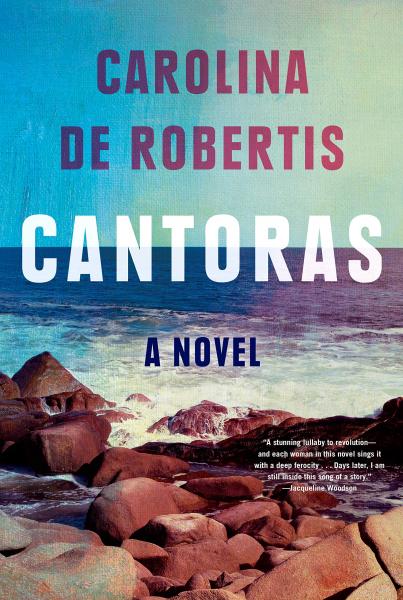interviews
Queer Pleasure Is a Form of Resistance
"Cantoras" imagines the lives of five queer Uruguayan women during the dictatorship

Cantoras follows five Uruguayan queer women, exploring their friendships with one other, their personal trials and traumas, and their romantic and sexual selves. The novel is primarily set during the dictatorship years, 1973–85, a time marked by violence, torture, and severely restricted personal freedoms. These Cantoras—“cantoras,” the Spanish word for singers, is used as a code word by queer women for protection and identification—find refuge in each other, and in a secret retreat they make together by a rural beach.
Written in prose that sings, Cantoras is a sweeping, compassionate novel. In the year that we celebrated the 50th anniversary of the Stonewall uprising, the riots that incited the gay liberation movement in the United States, this is a novel that asks profound questions about nationality, belonging, and identity.
I was delighted for the opportunity to ask Uruguayan American writer Carolina De Robertis about her process writing sex-positive sex scenes between women, pleasure as resistance, global queerness, unlikable queer women of color, among other topics of conversation.
Alexia Arthurs: I want to start with a point of view question. I so admire the craft of Cantoras because I could sense that it was the kind of novel that would teach me in equal parts about my own writing and myself. It was affirming to read a novel that follows the lives of five different queer women, because too often the experiences of queer women are presented as a singular story. What were the experiences and challenges of writing a novel that follows Romina, Flaca, Anita, Paz, and Malena—five different points of view? Were you thinking about queer diversity?
Carolina De Robertis: I knew from early on, writing Cantoras, that it would be told in a prismatic point of view that moved fluidly between the characters. It had to be this way because the real women whose lives inspired this book drew strength from friendship and community during the Uruguayan dictatorship—a time of intense silence and isolation. So the approach felt true to the story, and arose from it. That said, I also found it incredibly freeing to write this way. It unleashed me from the pressures of representation that so many of us face as marginalized writers, because no one story is the story. These five women are incredibly different from each other, and that, obviously, is also true about queer women. We deserve all that space, to be more than sidekicks, to be raucous and multivalent in our expression.
AA: I started reading Cantoras with the knowledge that it’s about five queer women living under the Uruguayan dictatorship, a period during which many human rights were stripped from Uruguayans and being identified as queer could lead to violent consequences, and so I was really struck by all the pleasure in this book—in the having of sex, the descriptions of food and drink, and the oceanic views of Cabo Polonio. I was moved by the bravery of these women seeking out pleasure, especially as I considered how pleasure for women is a kind of resistance across cultures and time periods. Did you set out to write a book so interested in women’s pleasure?
I don’t think we’ll ever reach liberation—as women, or as queer people—without affirming our true erotic selves, or our right to joy.
CdR: What I knew was that I wanted to write a book about liberation: what it means, what it costs us, why we need it, how we carve it from the world, how we get there. And perhaps this will sound radical, but I don’t think we’ll ever reach liberation—as women, or as queer people—without affirming our true erotic selves, or our right to joy. James Baldwin knew this; in Another Country, the most undersung masterpiece of the 20th century, he takes us deep into the connections between pleasure and agency, desire and survival. Audre Lorde knew it too, lying it out in her essay “Uses of the Erotic: the Erotic as Power.” I’m so glad you saw pleasure as a form of resistance in this book—along with all the other forms of resistance the women pursue.
AA: And speaking of pleasure, Cantoras is such a sex-positive book. I was inspired by the abundance of sex between women, and sex between women that isn’t interested in the male gaze. I remember having a conversation with another writer about the challenges of writing good sex scenes, and the writer wondered if a part of the challenge is how it might implicate a writer by revealing something about their sexual selves. Now, I can’t help wondering if a part of the work of writing sex scenes is becoming more comfortable with our sexual selves. What advice would you offer to someone looking to write better sex scenes? And in thinking and writing about desire and sex, who do you look to for inspiration, literary or otherwise?
CdR: These are intriguing thoughts. For too long, for centuries, sex between women has not been perceived as valid literary material, and that’s a shame. We’ve lost a great deal. Imagine the hundreds of pages we could have had on what Clarissa Dalloway wished she’d done with Sally Seton. I’m talking treasures, here. With this novel, and the one before it, The Gods of Tango, I struggled with the thought that the more dyke sex landed in the book, the less it would get taken seriously. But then I’d remember Henry Miller and how he got taken plenty seriously with all his extravagant descriptions of straight male desire, and I’d dive back in. In terms of advice, I’d say, trust your imaginings, follow the particular, be true to the body, and listen for what feels too weird or raw or risky—and go there. You can always revise. But first, say it. Give it voice. There’s so much that still needs giving voice.
AA: I’m writing a novel about a group of black women friends, so in a deeper way I was especially grateful for the friendships in Cantoras. I paused from reading to text a friend, “Why is it a thing for queer women to be friends with their exes?” My sense and my own relationship to queerness is that it feels outside of heterosexual ways and limitations of experiencing relationships. What’s your thinking about this novel’s interest in friendship? Perhaps the ways it holds and challenges certain stereotypes about friendships between queer women?
CdR: The idea of lesbians or queer women being friends with their exes is a stereotype, but it’s also something I’ve seen play out both here in the United States and among the women I met in Uruguay who inspired this book, and who are a generation older than me. And in fact, it makes sense: the community they forged was so small, contained, and under the radar that they couldn’t afford to lose too many people to break-ups. You’d end up alone. And yes, I do think another factor lies in stepping outside heteronormative ideas of what a relationship means or can be.
For too long, sex between women has not been perceived as valid literary material, and that’s a shame.
What I really wanted to portray, in this book, is one of the great innovations and gifts of queer culture: chosen family. Queer friendships, both in and beyond intimate relationships, have long stitched together families and communities for those who’ve been expelled from their original homes—one character in the novel describes it as a kind of patchwork quilt made up of remnants no one else wanted. But they wanted each other. It’s more than friendship; it’s a kind of family-making, less socially recognized than other forms, but no less real or powerful.
AA: I was wrecked by the relationship between Romina and Malena—I couldn’t hold Romina’s trauma against her, and the reasons she couldn’t know Malena intimately, and yet I felt personally betrayed. I was also distressed by the age difference and issues of consent when thinking about Paz and Puma.
You write about women with such intimacy and complexity—the light, but also the shadowy parts. Much has been said about writing “unlikeable” women, but usually it is referring to white, straight women. What does this idea of writing unlikeable women mean for you personally?
CdR: If we only write flat characters to portray our marginalized communities, we’ll never be truly free. Saintliness is a kind of flattening, too. It doesn’t allow the characters to be complex, textured, containing of multitudes, as Whitman put it. Romina, Malena, Paz, Puma—they’re more than that. We’re all more than that.
AA: I was really interested in how the novel explores the language of queer identity. During the dictatorship, “cantoras,” which is translated as singers, is used as a codeword by lesbians to identify themselves. Later, the Cantoras contemplate the younger generation of queers in the new democracy, who claim different identity markers within the LGBTQ+ community. Flaca says, “Now we have all these words and nobody’s a cantora anymore…Don’t you ever feel like you’re disappearing?” I’m interested in this tension around the generational language of queer identity—this idea of “disappearing.” What do you think Flaca means by it? It occurs to me now that this novel is a record, a remembering of this particular period in Uruguayan history—but of the cantoras too, is that right?
CdR: I think that is right—or, at least, that’s my intention. I felt a great responsibility, writing this book, to do my best to create a record, a fictional rendering to address the immense archival silence. I’ve been researching the Uruguayan dictatorship for eighteen years now, for various projects, and have shelves of books on the topic in both English and Spanish. There is nothing on the experience of queer people living through those times. And yet, there I was, hearing these stories from people I knew personally, remarkable stories that deserved voice in the world.
In terms of queer language, absolutely: there have been enormous generational changes, in Uruguay, and in the United States as well. Our queer lexicon is kaleidoscopic and continuously evolving; we can affirm this and also honor our various histories.
AA: I was also interested in how this novel navigates global queerness. Paz names her bar La Piedrita—Little Stone—after Stonewall. And in the last part of the novel, gay marriage is legalized in Uruguay: “Uruguay being the third country in America to legalize gay marriage, after Canada and Argentina, and before the United States.” Can you speak to the novel’s interest in global queerness? How were you thinking of Uruguay in this larger conversation about global queer liberation?
Queer friendships have long stitched together families for those who’ve been expelled from their original home.
CdR: People often assume that Latin America is “backward,” and that Latin Americans or Latinx people are more sexist and homophobic than, say, white people in the U.S. If I had a buck for every time I’ve been informed that my culture is more “traditional” or “conservative” than others, I’d be rich! So it was important for me to include the more recent era of progressive renewal in Uruguay, when, yes, we legalized gay marriage before the U.S. Though as you say, there’s also a character who’s inspired and moved by Stonewall, so what happened in the U.S. does transcend its borders. That’s how queer liberation has worked, globally—every brave movement, every breaking of silence, has sent sparks across the world.
AA: I’m remembering a conversation between the Cantoras about whether they feel at home in Uruguay during the dictatorship. I’m remembering the Afro-Uruguayan character, Virginia, who believes that her community was displaced by the racist government. She volunteers with a Black community paper. I’m thinking of Ariella, who longs to leave “this jail of a country,” though she is protected by her wealth and privilege. And I’m thinking too of the exiles whose letters and newspaper clippings Romina smuggles into Uruguay, Romina who bravely organizes to restore democracy. These are just a few of the personal narratives of belonging and national identity in Cantoras. How do you see Cantoras as holding this fraught question of belonging and national identity?
CdR: Belonging is, to me, a core theme of this novel. How do we shape a sense of home in a world that seems bent on our erasure? What does it mean to seek refuge, live our truth in hostile times? These are questions are intensely relevant to the novel’s characters, but they’re also, alas, relevant to many of us in the here and now. This novel doesn’t answer those questions, but it does create a space for the characters to explore them—and, hopefully, for the reader to explore them, too.









